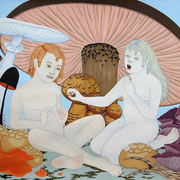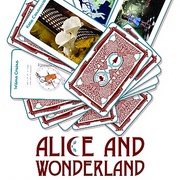A new art exhibit in the Perlman Teaching Museum at Carleton College promises to take audiences on a journey through ‘wonderland.’ Alice and Wonderland presents the works of four artists who visit the legendary destination made famous in Lewis Carroll’s imaginative childhood classic, “Alice’s Adventures in Wonderland,” via photography, computer technology, painting, drawing, and “magic” mushrooms. Alice and Wonderland opens Friday, April 5 from 7:30 to 9 p.m. with a reception and remarks by two of the featured artists, Kate Casanova and John Largaespada at 7:45 p.m. This exhibit is free and open to the public.
Carroll’s “Alice in Wonderland” has inspired artists since its initial publication in 1865. John Tenniel’s original illustrations helped define a cast of characters including the winsome, blonde Alice; the March hare; the Red Queen; the Mad Hatter; the Cheshire Cat; the Caterpillar, and more. Over the years, many illustrators and fine artists have re-interpreted and elaborated on the visual world that is ‘Wonderland.’
Carleton College’s exhibition, Alice and Wonderland, presents works by four visual artists, three from Minnesota and one from South Africa:
John Largaespada, calling himself an image maker, interprets scenes from classic literature. His two large works, presenting two different versions of the heroine, are composite images developed with live models, photographs, and image manipulation by computer. Trained at the Minneapolis College of Art and Design, Largaespada shows his process in an episode of Twin Cities Public Television’s “MNOriginal.”
Alexa Horochowski, a multi-media artist who teaches at St. Cloud State University, projects prepubescent females onto walls, paintings, and other formats. These young women, simultaneously innocent and knowing, have fairytale-like adventures. In the works at Carleton, Alice meets Frankenstein at the Mad Hatter’s Tea Party while in another work, her alter-ego samples magic mushrooms.
Kate Casanova, who studied at the Perpich Center for Arts Education, the Minneapolis College of Art and Design (MCAD), and now the University of Minnesota, blends natural and man-made materials to create “thought objects” and new meaning. Her contribution to Alice and Wonderland—a plush ottoman sprouting exotic mushrooms—connects powerfully, if indirectly, to Lewis Carroll’s classic text. Casanova was also the subject of a profile on TPT’s “MNOriginal.”
Wilma Cruise is a South African visual artist and sculptor working mainly with fired clay. With her Alice Project, comprised of sketches, annotations, and exhortations to herself, Cruise explores the fraught relationship between humans and animals. “Re-visiting my childhood texts of ‘Alice in Wonderland’ and ‘Alice Through the Looking Glass,’ I found an inversion of the traditional relationship between animal and humankind. In Wonderland it is the animals that have the knowledge. Alice, as the human, is the one who lacks the key of understanding.”
To learn more about the artists featured in Alice and Wonderland and to see samples of their work, visit the exhibition website at go.carleton.edu/alice/.
Alice and Wonderland is on display in conjunction with the Carleton Players’ performance of “Alice in Wonderland,” being presented April 11 through 14 in collaboration with St. Olaf College and Minneapolis’ renowned dance-theater company, Flying Foot Forum. Directed by Flying Foot Forum’s Joe Chvala, performances are free and open to the public. Reservations are strongly encouraged and can be made online at carleton.tixato.com/buy.
Alice and Wonderland is on display in the Kaemmer Family Gallery of the Perlman Teaching Museum in the Weitz Center for Creativity through April 28, 2013. The Weitz Center for Creativity is located at Third and College Streets in Northfield. Hours are: Monday–Wednesday: 11:00 a.m.–6:00 p.m.; Thursday–Friday: 11:00 a.m.–9:00 p.m.; Saturday: noon–4:00 p.m.; and Sunday: closed. For more information, call 507-222-4342 or 4469 or visit go.carleton.edu/museum.





